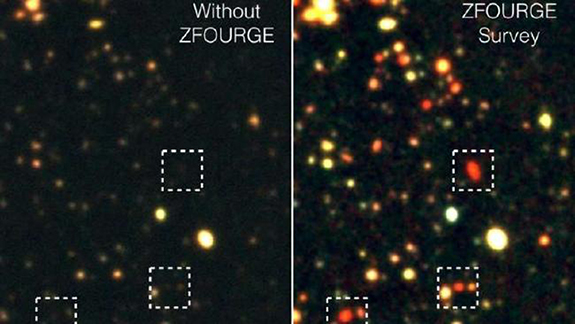Astronomers find diversity in Ancient Universe

In Summary
- Astronomers have charted the rise and fall of galaxies over 90 per cent of cosmic history
An international team of astronomers has built an accurate multi-coloured 3D map of galaxies showing them growing from faint beginnings to mature and majestic giants.
The FourSTar Galaxy Evolution Survey (ZFOURGE) has captured the light of over 70,000 galaxies and measured how far they are from our own Milky Way galaxy to create a snapshot of galaxies spanning more than 12 billion years.
“ZFOURGE provides crucial details of galaxies, such as their mass and distance. With this information we can more accurately trace the growth of galaxies over cosmic time and possibly uncover different growth pathways,” says Swinburne University of Technology PhD student and co-author Rebecca Allen.
The ZFOURGE team assembled a colourful photo-album using a new set of filters that are sensitive to infrared light. They took images during 45 nights at the 6.5 meter Magellan Telescope in Chile.
"Perhaps the most surprising result is that galaxies in the young Universe appear as diverse as they are today,” says Dr Caroline Straatman, recent graduate of Leiden University and lead author of a paper published in the Astrophysical Journal.
“The variety of galaxies in this survey helps us study whether nature or nurture is primarily responsible for the evolution of galaxies in the early Universe into massive galaxies with little to no star-formation that we find around our Milky-Way,” says fellow Swinburne PhD student and co-author Themiya Nanayakkara.
ZFOURGE is full of surprises
In the first images taken in the study, the team found one of the earliest examples of a galaxy cluster, a 'galaxy city' made up of a dense concentration of galaxies, which developed when the Universe was only three billion years old.
“This finding is much like discovering an ancient city that existed earlier than any other known city,” says co-author Dr Lee Spitler from Macquarie University in Sydney.
The deep 3D map also revealed young galaxies that existed 12.5 billion years ago where current technologies have only found a handful of such galaxies.
“The ZFOURGE team has already produced 15 published discoveries leading to an increased understanding of how galaxies evolve. These data will have a long lasting legacy value. We are excited to now release it to the community so that others can address outstanding problems in galaxy evolution,” says Swinburne co-author Dr Glenn Kacprzak.

